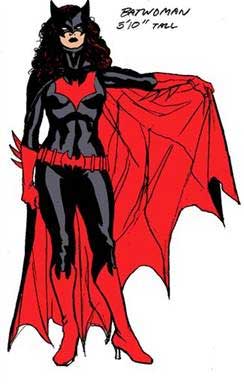
What does socionomics say about announcements like DC Comic's announcement that "Batwoman Is Back As a Lesbian"?
--Gary Nichols
It fits right in with our comment from 2001, which came out when Hannibal hit it big at the box office (the full discussion appears at the bottom of this entry). A gay Batwoman certainly fits EWI’s “complex anti-hero” description. Believe it or not, it should get far more extreme before it is exhausted. Most remaining bull market style heroes will fall from public grace and attention, and bear market style anti-heroes will take their place. The preference for antiheroes is evident by the latest DC Comics story line in which Batman “has disappeared, along with Superman and Wonder Woman, leaving Gotham a more dangerous place.”
As for Batwoman’s revised sexual preference. This is also consistent with the position of social mood as the entries of Febraury 16, November 15 and September 7 reveal.
March 2001, EWFF
New Role Model
In 1985, EWT identified bear markets as the domain of complex anti-heroes. Hannibal “the Cannibal” Lecter certainly fits the bill. First, recall that Hannibal Lecter played an important but not central role in the 1991 horror movie Silence of The Lambs, which rode the cultural after-shocks of the last bear market in social mood to critical and box office success. Now Lecter is back as the focal point in Hannibal, and he is “bloodier and more violent” than ever. As the cutting edge in a new wave of horror movies, the most important element of this blockbuster is that Hannibal manages to gain the sympathies of the audience. “Here’s a thriller in which, by the end, you are rooting for a serial-killing cannibal to escape his hunters,” says one reviewer. As grisly as this seems, audiences are clearly thirsty for such a character. Hannibal had the best opening ever for an R-rated movie, grossing more in its first weekend than the next 15 movies combined. Hannibal signals a profound shift from the horror films produced by the downturns of the 1930s and 1970s. In the 1930s, the monsters got killed by the heroes; in the 1970s, the heroes got killed by the monsters; this time around, the monsters are the heroes. These are profound shifts that will undoubtedly put traditional, white-hat heroes that rule in bull markets on the sidelines for some time to come.
|
